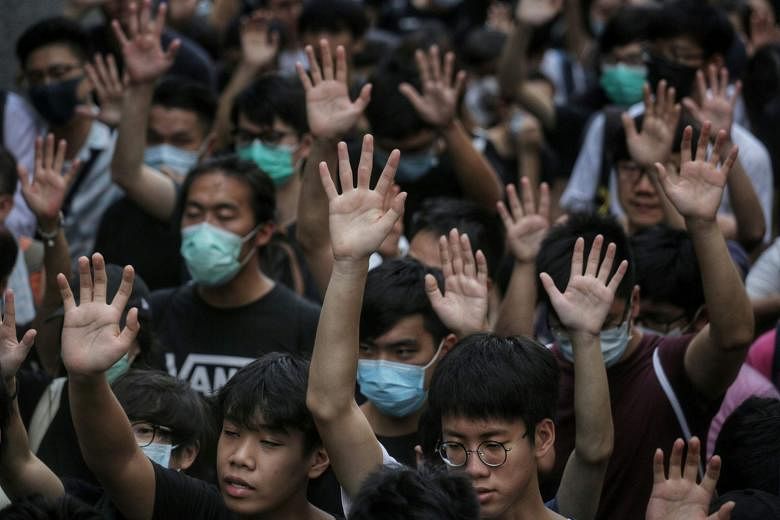BANGKOK • Hong Kong and Thailand have both seen their streets filled with protesters daring to take on an entrenched political elite and discuss once-taboo subjects in their push for greater freedoms.
Political analyst Voranai Vanijaka, from Bangkok's Thammasat University, said tech-savvy youth in both territories have "shared cultural values".
"It's the love for freedom and the courage to fight for change."
Here are five similarities between protesters in Thailand and Hong Kong:
1. TAKING ON POWERFUL TARGETS
Both movements are primarily motivated by inequality and the desire for democracy, but in pushing for a greater say in how their fates are forged, they are taking on formidable foes resistant to change.
For Hong Kong, it is the ruling Chinese Communist Party, which crushes dissent on the mainland and has increased control over the restless semi-autonomous city.
Beijing has rejected the protesters' calls for greater democracy and police accountability, and has, since June 30, imposed a national security law on the financial hub that has snuffed out mass dissent for now.
In Thailand, it is the monarchy - backed by the powerful military - that sits at the apex of the political pyramid.
For now, it is unclear how the palace will react to the protests, but in previous periods of turbulence, it has played a pivotal role in deciding the outcome.
2. RULE OF LAW OR RULE BY LAW?
The way the authorities use the law has been a key catalyst.
The initial spark in Hong Kong was an eventually aborted extradition Bill, which would have allowed people to be sent to mainland China for trial in courts controlled by the Communist Party.
The protest then morphed into an anti-government movement and a wider push for universal suffrage.
In Thailand, the kingdom's draconian lese majeste law - which shields the monarchy from criticism - has been a crucial component of calls for reform, as well as prosecutions under broadly worded sedition and cybercrime laws.
Multiple critics of the Thai monarchy have also disappeared, with the Human Rights Watch recording at least nine cases involving activists overseas.
The current round of protests came after Thai pro-democracy activist Wanchalearm Satsaksit was allegedly kidnapped in Cambodia in June. He has not been seen since.
3. YOUTH-LED
Young people are at the heart of the calls for reform.
Hong Kong's huge rallies represented a broad swathe of society, from students to lawyers, bus drivers, civil servants and teachers.
But the front-line activists - and those embracing increasingly violent tactics - were overwhelmingly young. Many face prosecution and years in jail.
Some of Hong Kong's most visible activists, such as Joshua Wong and Ms Agnes Chow, were teenagers when they first got involved in politics.
Thailand's protest leaders - most of whom have been arrested in the past week - are in their early 20s and are similarly more willing to embrace confrontational tactics than older generations.
4. TABOOS SHATTERED
Taboo topics have been thrust centre stage.
In Hong Kong, young activists were more willing than their older counterparts to embrace the idea of autonomy and even outright independence from China - a concept that remains a red line for Beijing.
As the protests dragged on and the authorities refused major concessions, chants and flags declaring "Liberate Hong Kong, revolution of our times" became commonplace.
In Thailand, even talking about the concept of reforming the monarchy is enough to land someone in jail. But people have begun to lose that fear.
Young activists have given speeches calling for the lese majeste law to be abolished and called for the king's huge personal wealth - estimated to be some US$60 billion (S$81.4 billion) - to have a clear division of assets between public and personal.
5. PROTEST TACTICS
Thai protesters donned hard hats, goggles, gas masks and umbrellas against water cannon over the weekend in images that could have come straight out of Hong Kong last year.
Young activists in both places have also swopped tactics online and offered messages of support.
Links have grown between protesters through a so-called Milk Tea Alliance, referring to drinks popular in both places.
Both protest movements are using encrypted social messaging platforms to mobilise and have opted for flash mob rallies - especially since the authorities arrested key leaders.
Hand symbols have also taken centre stage.
In Hong Kong, a raised palm symbolises the "Five demands, not one less" slogan.
Thais, meanwhile, have embraced a three-finger salute from the dystopian Hunger Games movies.
AGENCE FRANCE-PRESSE

